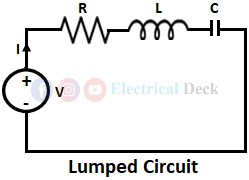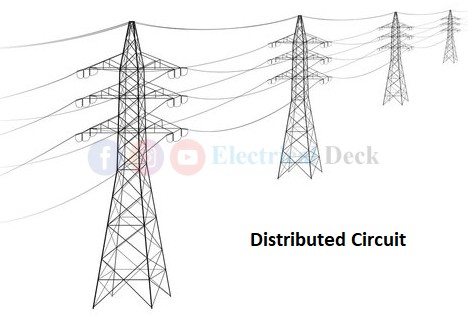An electrical circuit is simply an interconnection of various electrical elements or components forming at least one closed path so that electric current flows. An electrical element is the basic building block that provides, consumes, or controls electrical energy in a circuit.
The interconnection of one element to another in a circuit is made by a conducting medium such as wires. Numerous electrical circuits are built using various components to perform a desired function.
In general, the circuit elements can be categorized as,- Active and passive elements,
- Unilateral and bilateral elements,
- Linear and non-linear elements,
- Lumped and distributed elements.
In this article let us learn about lumped and distributed elements with examples.
Lumped Elements :
An electrical element that is assumed to be concentrated in one place or located in a smaller space in the circuit is said to be known as a lumped element. Lumped elements can be physically separated from the circuit for analysis purposes.
The physical size of a lumped element is negligibly small than the wavelength of applied voltage and current. The physical quantities such as voltage and current of lumped elements are function of time alone.
The net effect of electrical phenomena occurring in a lumped element can be described in terms of voltage and current variables across the terminals of the element and doesn't depend on their geometrical shape or internal structure.
A resistor, inductor, capacitor, diode, etc, are examples of lumped elements.
Lumped Circuit :
An electrical circuit in which all the elements are lumped is called a lumped circuit. Below shows an example of a lumped circuit composed of discrete elements such as resistors, capacitors, and inductors.
In the above circuit, it can be seen that the resistor, capacitor, and inductor are located at a single point and all the elements can be separated from the circuit. The resistor, inductor, and capacitor have fixed values.
Distributed Element :
An electrical element that is assumed to be distributed across the entire length of the circuit is called a distributed element. Unlike lumped elements, distributed elements are not concentrated in a single place. Distributed elements cannot be separated from the circuit since they are distributed everywhere in the circuit.
The physical size of a distributed element is comparable with the operating wavelength. The physical quantities such as voltage and current of distributed elements are function of both time and geometrical shape (area or length).
The resistance, capacitance, and inductance components distributed uniformly along a transmission line are examples of distributed elements.
Distributed Circuit :
An electrical circuit with one or more distributed elements is known as a distributed circuit. A transmission line is the best example of a distributed circuit. In transmission lines, the components like resistance, capacitance, and inductance are distributed all along its length which cannot be separated. Other examples of distributed circuits include coaxial cables, hollow waveguides, etc.
Difference Between Lumped and Distributed Elements :
| Lumped Element | Distributed Element |
|---|---|
| An electrical element or component which is concentrated at a single point or place is said to be known as a lumped element. | An electrical element or component which is distributed all along the circuit is called a distributed element. |
| The size of lumped elements is smaller than the wavelength of applied voltage and current. | The size of distributed elements is comparable to the wavelength of applied voltage and current. |
| lumped elements can be separated from the circuit. | Distributed elements cannot be separated from the circuit. |
| The voltage and current in a lumped element are a function of time alone. | The voltage and current in a distributed element are function of space and time. |
| A lumped circuit is one in which all the electrical elements are lumped. | An electrical circuit with at least one distributed element is known as a distributed circuit. |
| A lumped circuit is easy to understand and analyze. | A distributed circuit is difficult to understand and analyze compared to a lumped circuit. |
| Examples of lumped elements are resistors, inductors, capacitors, diodes, transistors, etc. | Examples of distributed elements are resistance, inductance, and capacitance of a transmission line, etc. |


